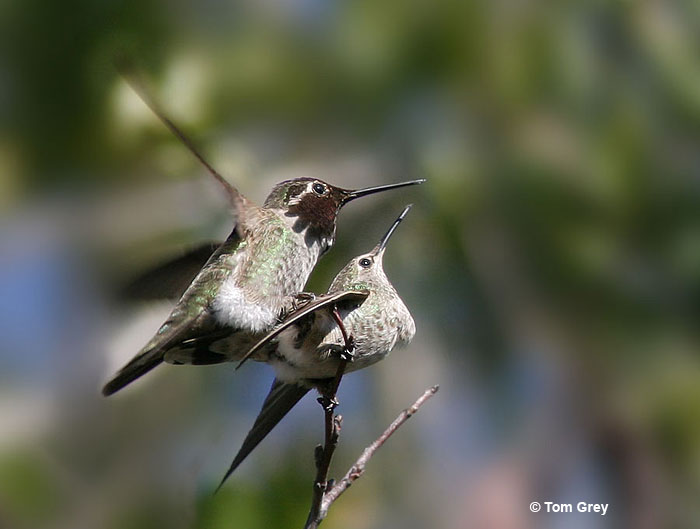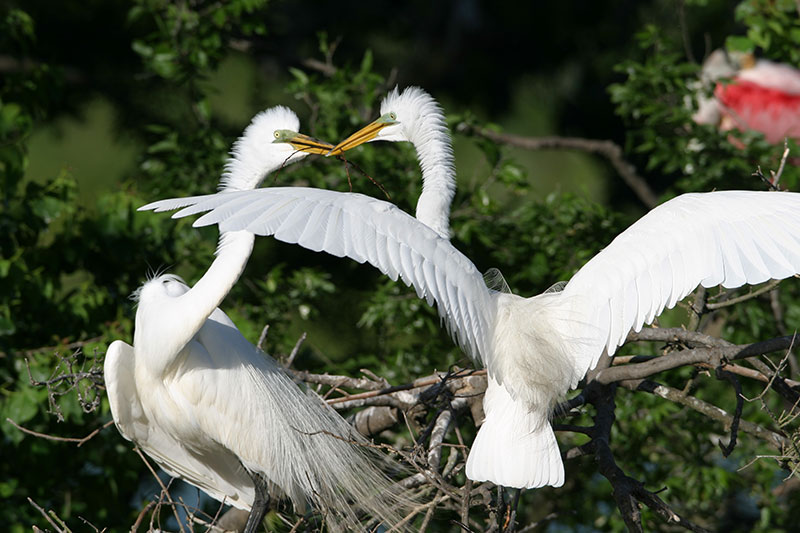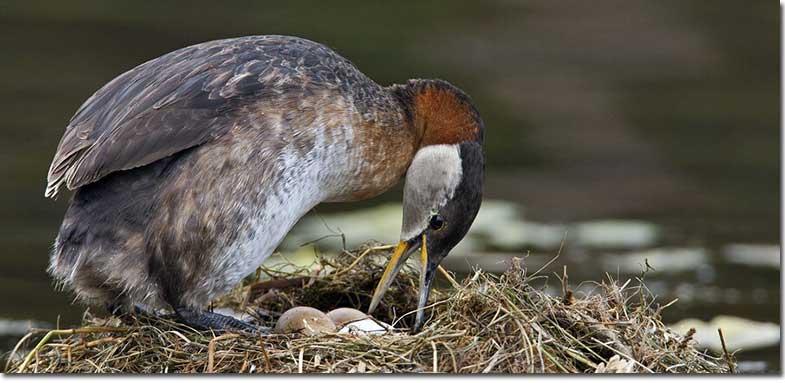
It is no secret that birds exhibit some of the most intriguing courtship and mating behaviors in the animal kingdom. Due to their strong social bonds, birds are also caring partners and parents, leading them to become symbols of love, affection, dedication, and faithfulness in human cultures across the globe.
However, the avian world also hides many “dirty secrets” – due to high competition, some bird species have evolved astounding and even shocking ways to ensure their parenthood.
If you’ve ever wondered how birds reproduce and the journey leading to it, let me take you on a fascinating journey exploring avian courtship, mating, and parenthood.
On this page
How Do Birds Reproduce?
Bird reproduction strategies vary drastically across species but share basic elements – courtship and nest building, mating, egg-laying, egg incubation, and parental care.
All these vary between bird species because they have all evolved under specific environmental and lifestyle pressures over millions of years. However, all share an impressive complexity of specific behaviors.

Great Egret Courtship
Let’s simplify and break down a typical bird reproductive cycle.
- When the young birds mature, during breeding season, males begin courtship, using various visual and vocal displays to attract a female.
- After the courtship phase, mating occurs, leading to the fertilization of eggs.
- Then, the female lays eggs in a nest (simple or elaborate) and incubates them until they hatch.
- After hatching, one or both parents take care of the chicks, usually displaying a high level of parental care.
- A couple may remain bonded for consecutive seasons (bird monogamy), or each bird may find a different partner in the next season.
As said before, each stage varies among different bird species due to their unique adaptations.
How Do Birds Mate? Starting With Courtship
Bird courtship usually involves various displays by the male of the species.
Songbird males – finches, juncos, and others – are known for their “songs,” amazing vocal displays that hope to sway usually silent females in their territory’s direction. However, it’s less known that territorial aggression is also a part of the courtship process and that songs are “sung” not only to females but to male rivals as well.
Other birds, like peafowl (peacocks) and birds of paradise, have elaborate physical displays. These include spreading the colorful plumage that serves no other purpose but displaying for females.
Often, a sort of “dance” is involved, too – the peacock struts and vibrates its long tail feathers while calling out to nearby females. The peahen watches these displays closely, looking to select a mate with the most impressive plumage and the most captivating performance.
Other interesting courting behaviors include mutual feeding and gift-giving observed in corvids and pigeons. The same goes for Magnificent Frigatebirds who have some interesting mating rituals.
Reproductive Anatomy
Birds have a reproductive anatomy much different from ours – it is more similar to reptiles than to mammals.
Related: Anatomy of Birds
Unlike mammals, birds do not possess external genitalia. Instead, they have a structure called a cloaca or a cloacal opening, also found in reptiles and amphibians. The cloacal opening serves various functions, including excretion and reproduction.
They also use this opening to discard their excrement.
Female Bird Reproductive Anatomy
Female birds have a two-part reproductive system. It consists of the ovary in which the eggs develop and the oviduct where the egg matures and fertilization happens.
Interestingly, only the left ovary and oviduct are developed and functional; the right pair is stunted during embryonic development. However, there have been examples where the left ovary-oviduct pair becomes damaged and non-functional, and the right pair subsequently develops enough to take over.
The oviduct has several sections, two of which serve to adorn the egg with a shell. The oviduct ends in the cloacal opening – that’s where the eggs come out during the laying process.

Image credit: Osprey Tales
Male Bird Reproductive Anatomy
The act of mating is shorter than you’d expect. A large majority of birds lack a penis or any other copulatory structure that could directly insert the sperm into the female cloaca. Instead, most birds mate through a technique called “cloacal kiss.”
In this short maneuver, the male mounts the female. Then, the birds rub their swollen cloacal openings together, allowing the male to transfer his sperm. The cloacal kiss allows the female to control the situation well because she needs to tilt at just the right angle for the sperm transfer to succeed.
Only around 3% of bird species have males with penises. These include waterfowl – ducks, geese, and swans, and large, primitive flightless birds such as ostriches, emus, and rheas.
Extreme Example: Ducks
Ducks are an unusual example of bird reproductive anatomy. Not only that, the males have penises – they are also cork-screw shaped and can be as long as the male’s body in some species.
To make things even more awkward, male ducks often seek out females outside of their pair bonds and will even try to mate forcefully. Scientific observations show that up to 10 percent of female Mallards within a group die each year by drowning during these violent mating attempts.

Ducks mate quite differently from other birds and can get pretty aggressive. © nccmrm97
The female duck‘s “vagina” – the modified oviduct – anatomically corresponds to these challenges: it is a long and winding structure.
From the natural selection point of view, it’s an evolutionary effort to control which males will father the ducklings after all the drama because female ducks seem to have a way of selecting and favoring particular sperm once it’s inside their system. Also, it is not uncommon that the ducklings in a single brood often come from different fathers.
In most other bird species, the breeding process is much swifter and less messy.
What Happens After Birds Mate?
Once the courtship, mating rituals, and nest building are complete, birds begin their seasonal parenting journey. The steps involved generally involve laying eggs, incubating them, nurturing hatchlings and young birds, and warding off potential threats. Most birds also continue to tend to their offspring weeks after they leave the nest.

Depending on the level of care the chicks need after hatching, bird species can be divided into altricial birds and precocial birds.
- Altricial chicks are born blind, nearly naked (covered only with thin downy feathers), flightless, and completely unable to take care of themselves. Parents of altricial species show an exceptionally high level of parental care. These include songbirds, pigeons and doves, corvids, birds of prey, and others.
- Precocial chicks hatch much better developed. They have juvenile feathers and can walk and forage for food. The level of parental care among precocial species varies. Chickens, pheasants, peafowl, and flightless birds are some notable examples of precociality.
Extreme Example: Emperor Penguins
Extreme conditions call for extreme measures. Thus, the Emperor Penguins, birds that inhabit some of the coldest places on Earth, have a unique approach to parenting.
In a frigid environment, there are no materials for nest building, and the eggs need to be kept more than 70 degrees Celsius warmer than the environment! Emperor penguins solve this challenge with one physical adaptation and harsh, spartan parental responsibility division.
After laying a single egg, the female leaves it to her partner over the winter while she is out fishing on the open sea.
The dedicated penguin dad will then use his feet and his egg pouch or brood patch – a special stretchy skin fold rich in blood vessels just below the belly. He will incubate the egg for up to 75 days at 38 degrees Celsius, battling the bitter cold of -35 degrees C and fasting for nearly four months during the entire process.
Once the well-fed female returns in the spring (July), she feeds the chick with the regurgitated fish. Finally, it’s the male’s turn to go out and find food. Despite being starved, females have to “persuade” a male to give the chick to her to nurture and keep warm – the strong bonding instinct makes it hard for Emperor Penguin dads to let go of their precious baby!
You Might Also Ask
Can birds be pregnant?
No, birds don’t get “pregnant” like mammals do. The term “pregnancy” usually involves having a true uterus – an organ that carries and nurtures developing babies inside of the mother’s body. Also, pregnancy ends with the birth of live offspring.
Birds lack a uterus and do not give birth to young. Instead, they lay eggs that develop and get fertilized in their oviducts.
Do birds have to mate to reproduce?
In the large majority of cases, yes. Birds typically need to mate to reproduce and fertilize their eggs, as the male’s sperm is necessary for the fertilization. In rare cases, like a certain percentage of turkeys, females can reproduce parthenogenetically. Parthenogenesis is a process where fertile eggs develop without sperm fertilization, meaning the female doesn’t need a mate or mating.
Are male and female bird cloacas the same?
No – male and female bird cloacas are similar but not identical in structure. For example, in Passerines and other birds, the male cloaca points upwards or forwards and usually has a crease between the opening and the abdomen – all in all, it is “raised.” The female bird’s cloaca typically points backward, with no notable crease.
How do birds deliver sperm?
During mating, the cloacas of the male and female come into contact for the transfer of sperm. The slight anatomical differences between the male and female cloaca allow for a successful “cloacal kiss” for sperm transfer and egg fertilization. In both sexes, the cloaca is a joint opening for the reproductive, urinary, and digestive systems.
In the 3% of bird species whose males have a penis, copulation occurs.
Conclusion
From courtship rituals to nest building to intricate parental care, birds have a unique reproduction cycle. It has certainly contributed to their evolutionary success – the special reproductive anatomy allows birds to mate efficiently without wasting too much energy.
Contrastingly, most birds have to invest much energy into the next phase – raising their young from egg to maturity.
Each step of the journey requires total dedication from parent birds.
One thing is sure – each bird species has its own captivating story of courtship, parenthood, and survival. These tales and observations continue to fascinate and inspire bird enthusiasts and nature lovers worldwide.
